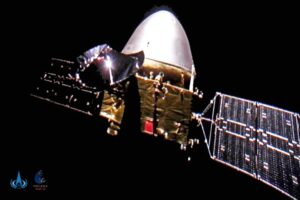NASA Acting Administrator Steve Jurczyk revealed the rare, but not unprecedented, discussions with China during a question-and-answer session after a March 23 speech at a meeting of the Federal Aviation Administration’s Commercial Space Transportation Advisory Committee, when a committee member asked him about what insight the agency had about Chinese space activities.
Jurczyk noted that NASA’s knowledge of China’s space program is largely limited to publicly available information because of restrictions placed by federal law on its interactions with Chinese organizations. Those restrictions do allow NASA to engage with China if approved by Congress.
“Most recently, we had an exchange with them on them providing their orbital data, their ephemeris data, for their Tianwen-1 Mars orbiting mission, so we could do conjunction analysis around Mars with the orbiters,” he said.
In a brief statement to SpaceNews late March 29, NASA confirmed it exchanged information with the China National Space Administration (CNSA), as well as other space agencies that operate spacecraft at Mars.
“To assure the safety of our respective missions, NASA is coordinating with the UAE, European Space Agency, Indian Space Research Organisation and the China National Space Administration, all of which have spacecraft in orbit around Mars, to exchange information on our respective Mars missions to ensure the safety of our respective spacecraft,” the agency said. “This limited exchange of information is consistent with customary good practices used to ensure effective communication among satellite operators and spacecraft safety in orbit.”
The statement, provided by NASA six days after SpaceNews first contacted the agency about Jurczyk’s comments, did not answer specific questions about the nature of the interaction between NASA and CNSA. Those questions included the level of risk the lack of accurate orbital data for Tianwen-1 posed to other Mars missions, and whether NASA was providing any warnings to CNSA of potential close approaches by Tianwen-1 to other spacecraft orbiting Mars.
NASA’s Jet Propulsion Laboratory operates a program called Multimission Automated Deepspace Conjunction Assessment Process (MADCAP) to perform conjunction assessments of spacecraft orbiting Mars. The program, originally called Mars Deepspace Collision Avoidance Process, also handles conjunction assessment for spacecraft orbiting the moon.
The handful of spacecraft currently orbiting Mars would appear to make odds of a collision between two of them remote. However, as JPL noted in a 2015 presentation about MADCAP, such spacecraft often operate in similar orbits, increasing the chances of close approaches. “The small number of assets makes the costs of collisions extremely high with respect to lost science capability,” it added.
MADCAP already incorporated orbital data from NASA’s Mars orbiters, as well as ESA’s Mars Express and ExoMars Trace Gas Orbiter spacecraft and ISRO’s Mars Orbiter Mission. However, in February, two new spacecraft entered orbit around Mars: the United Arab Emirates’ Hope and China’s Tianwen-1.
While the UAE was already cooperating with NASA on Hope, there was no cooperation with CNSA on Tianwen-1. China released little information publicly about the orbit of the spacecraft, which those familiar with the Mars program at JPL said had become a source of frustration because it made it difficult for them to predict any close approaches with other spacecraft. That was exacerbated by maneuvers Tianwen-1 made in the weeks after its Feb. 10 arrival to move into a “parking orbit” for the next few months.
Any exchange of information between NASA and CNSA or other Chinese organizations is restricted by what’s commonly known as the “Wolf Amendment” after former congressman Frank Wolf, who a decade ago chaired the House appropriations subcommittee that funds NASA and first included the restrictions. Similar provisions have been added to annual appropriations bills since then, including the fiscal year 2021 spending bill enacted in December.
Contrary to widespread industry belief, the Wolf Amendment does not categorically prohibit exchanges between NASA and Chinese organizations. The current version of the bill requires NASA — as well as the Office of Science and Technology Policy and the National Space Council — to certify with the Federal Bureau of Investigation that any proposed contacts with China pose no technology transfer or other national security concerns, and that those discussions will not include anyone the United States has determined to have been involved in human rights violations. NASA must notify Congress at least 30 days in advance of any proposed discussions with China.
While the Wolf Amendment is not an absolute prohibition on bilateral cooperation, it does have the effect of sharply reducing any collaboration. Jurczyk noted in his talk that NASA has previously won approval for discussions with Chinese organizations on topics like air traffic management and Earth science data. “We do have targeted engagement with them. We have the ability to certify to Congress that the engagement is appropriate and we have the safeguards in place,” he said.
It’s unclear if the exchange of information on orbital data will extend to data on operations of other phases of the mission, such as the deployment of a lander by Tianwen-1 as soon as May. Scientists working on NASA’s InSight Mars lander hope to record the acoustic and seismic signals created by the lander as it enters the Martian atmosphere and lands, but doing so requires more information about the spacecraft and the timing of its landing. Scientists said in February that the Wolf Amendment made obtaining that information difficult.
There have been efforts by some in the space community for years to allow greater cooperation between NASA and China, but that has not yet led to major changes in the Wolf Amendment. “It’s going to be up to the administration and Congress to determine if and how we engage with China on civil space activities as part of a broader strategy for the nation with China,” Jurczyk said.



